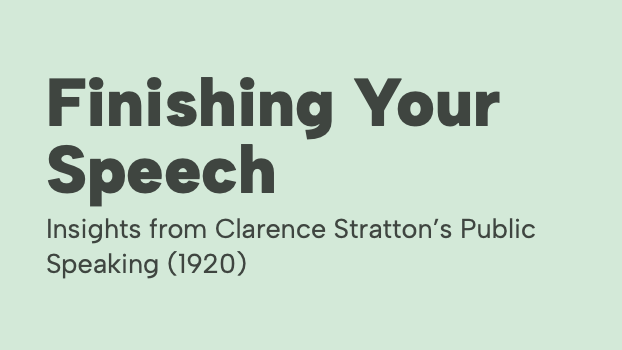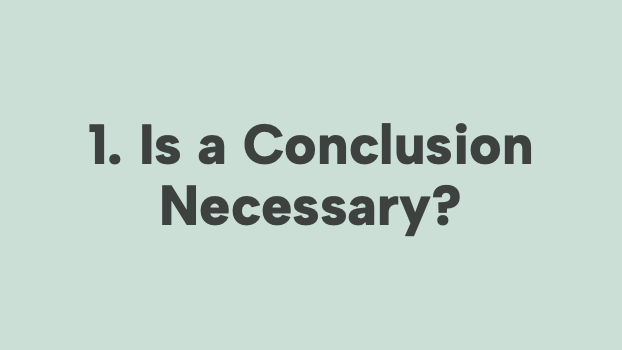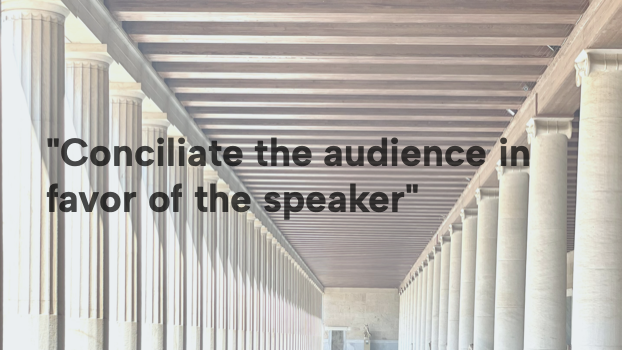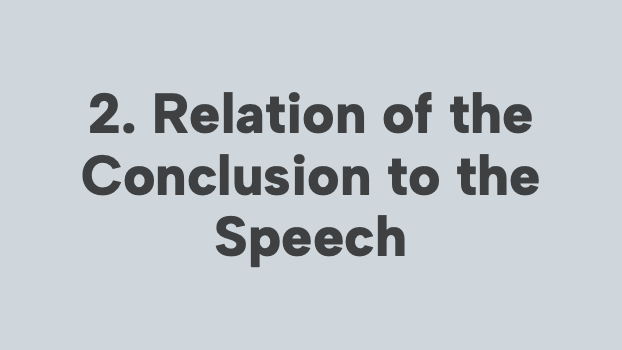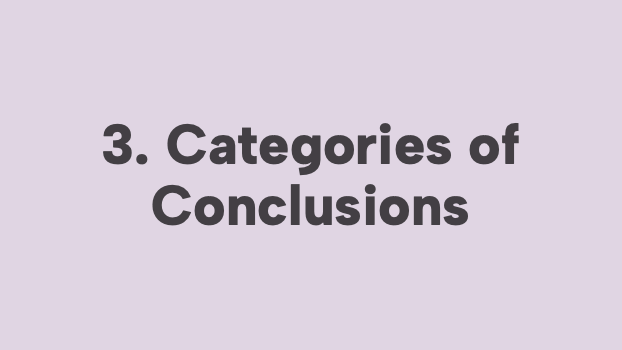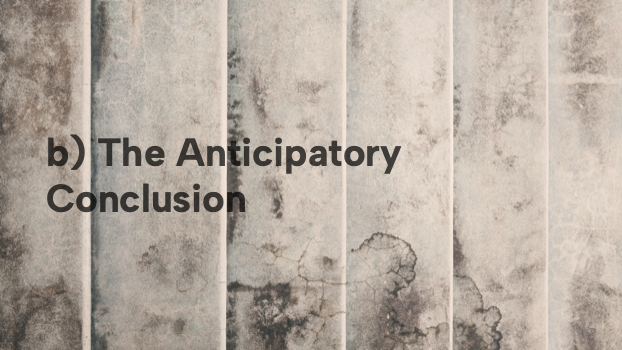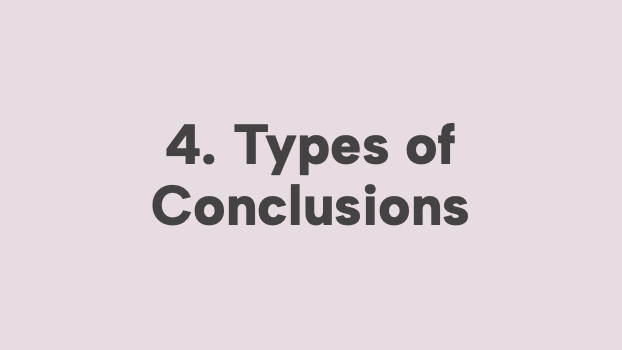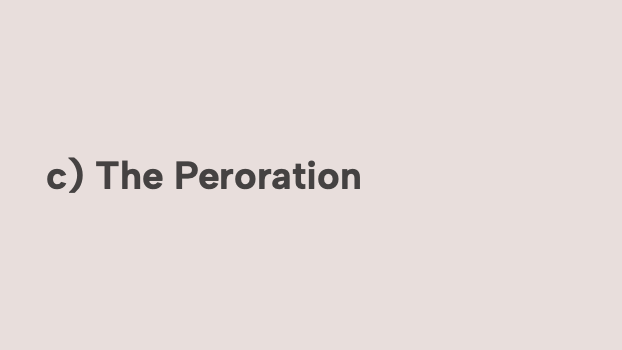Finishing Your Speech
Insights from Clarence Stratton’s Public Speaking (1920)

Preparing the conclusion. No architect would attempt to plan a building unless he knew the purpose for which it was to be used.
No writer of a story would start to put down words until he knew exactly how his story was to end. He must plan to bring about a certain conclusion.
Prepare For It
The hero and heroine must be united in marriage. The scheming villain must be brought to justice.
Or if he scorn the usual ending of the "lived happily ever after" kind of fiction, he can plan to kill his hero and heroine, or both; or he can decide for once that his story shall be more like real life than is usually the case, and have wickedness triumph over virtue.
Whatever he elects to do at the conclusion of his story, whether it be long or short, the principle of his planning is the same—he must know what he is going to do and adequately prepare for it during the course of, previous events.
The Most Interesting Part
One other thing every writer must secure. The ending of a book must be the most interesting part of it. It must rise highest in interest. It must be surest of appeal.
Otherwise the author runs the risk of not having people read his book through to its conclusion, and as every book is written in the hope and expectation that it will be read through, a book which fails to hold the attention of its readers defeats its own purpose.
The foregoing statements are self-evident but they are set down because their underlying principles can be transferred to a consideration of the preparation of conclusions for speeches.
1. Is a Conclusion Necessary?
"Having nothing more to say, I shall now close."
There are some people—thoughtless, if nothing worse—who habitually end letters by adding some such expression as "Having nothing more to say, I shall now close." Is there any sense in writing such a sentence? If the letter comes only so far and the signature follows, do not those items indicate that the writer has nothing more to say and is actually closing?
Why then, when a speaker has said all he has to say, should he not simply stop and sit down? Will that not indicate quite clearly that he has finished his speech? What effect would such an ending have?
Do Not Be Rude
In the first place the speaker runs the risk of appearing at least discourteous, if not actually rude, to his audience.
To fling his material at them, then to leave it so, would impress men and women much as the brusque exit from a group of people in a room would or the slamming of a door of an office.
Check Their Understanding
In the second place the speaker runs the graver risk of not making clear and emphatic the purpose of his speech. He may have been quite plain and effective during the course of his explanation or argument but an audience hears a speech only once.
Can he trust to their recollection of what he has tried to impress upon them? Will they carry away exactly what he wants them to retain? Has he made the main topics, the chief aim, stand out prominently enough? Can he merely stop speaking? These are quite important aspects of a grave responsibility.
A Complete Work
In the third place—though this may be considered less important than the preceding—the speaker gives the impression that he has not actually "finished" his speech.
No one cares for unfinished articles, whether they be dishes of food, pieces of furniture, poems, or speeches. Without unduly stressing the fact that a speech is a carefully organized and constructed product, it may be stated that it is always a profitable effort to try to round off your remarks.
A good conclusion gives an impression of completeness, of an effective product. Audiences are delicately susceptible to these impressions.
"Conciliate the audience in favor of the speaker"
Twenty-two centuries ago Aristotle, in criticizing Greek oratory, declared that the first purpose of the conclusion was to conciliate the audience in favor of the speaker. As human nature has not changed much in the ages since, the statement still holds true.
Speakers, then, should provide conclusions for all their speeches.
Although the entire matter of planning the speech belongs to a later chapter some facts concerning it as they relate to the conclusion must be set down here.
2. Relation of the Conclusion to the Speech
The conclusion should reflect the purpose of the speech. It should enforce the reason for the delivery of the speech.
As it emphasizes the purpose of the speech it should be in the speaker's mind before he begins to plan the development of his remarks. It should be kept constantly in his mind as he delivers his material.
A test to know...
One is tempted to say that the test of a good speech, a well-prepared speech, is its conclusion.
How many times one hears a speaker floundering along trying to do something, rambling about, making no impression, not advancing a pace, and then later receives from the unfortunate the confession, "I wanted to stop but I didn't know how to do it."
... where to end.
No conclusion had been prepared beforehand. It is quite as disturbing to hear a speaker pass beyond the place where he could have made a good conclusion.
If he realizes this he slips into the state of the first speaker described in this paragraph. If he does not realize when he reaches a good conclusion he talks too long and weakens the effect by stopping on a lower plane than he has already reached.

This fault corresponds to the story teller whose book drops in interest at the end. The son of a minister was asked whether his father's sermon the previous Sunday had-not had some good points in it.
The boy replied, "Yes, three good points where he should have stopped."
Length of the Conclusion
It must not be inferred from anything here stated concerning the importance of the conclusion that it need be long.
A good rule for the length of the conclusion is the same rule that applies to the length of the introduction.
It should be just long enough to do best what it is intended to do.
Intro | Outro
As in the case of the introduction, so for the conclusion, the shorter the better, if consistent with clearness and effect.
If either introduction or conclusion must deliberately be reduced the conclusion will stand the most compression.
A conclusion will frequently fail of its effect if it is so long that the audience anticipates its main points. It fails if it is so long that it adds nothing of clearness or emphasis to the speech itself.

It will end by boring if it is too long for the importance of its material. It will often produce a deeper, more lasting impression by its very conciseness.
Brevity is the soul of more than mere humor. A brief remark will cut deeper than a long involved sentence.
The speaker who had shown that the recent great war fails unless the reconstruction to be accomplished is worthy needed no more involved conclusion than the statement, "It is what we do tomorrow that will justify what we did yesterday."
A Balance to Find
Coupled with this matter of effect is the length of the speech itself. Short speeches are likely to require only short conclusions. Long speeches more naturally require longer conclusions.
3. Categories of Conclusions
a) The Retrospective Conclusion
A conclusion may be entirely retrospective. This means merely that it may refer back to the remarks which have been delivered in the body of the speech.
A speaker does this to emphasize something he has already discussed by pointing out to his audience that he wants them to remember that from what he has said.
Emphasizes, Repeats, Clarifies, Enforces
Conclusions of this kind usually have no emotional appeal. They are likely to be found in explanatory addresses, where the clearness of the exposition should make hearers accept it as true.
If a man has proven a fact—as in a law court—he does not have to make an appeal to feeling to secure a verdict. Juries are supposed to decide on the facts alone.
This kind of conclusion emphasizes, repeats, clarifies, enforces.
b) The Anticipatory Conclusion
Just as a conclusion may be retrospective, so it may be anticipatory.
It may start from the position defined or explained or reached by the speech and look forward to what may happen, what must be done, what should be instituted, what should be changed, what votes should be cast, what punishment should be inflicted, what pardons granted.
If one will think of the purposes of most delivered speeches he will realize that this kind of conclusion is much more frequent than the previous kind as so many speeches anticipate future action or events.
Two in One?
While it does not occur so frequently as the two kinds just illustrated it is possible for a conclusion to be both retrospective and anticipatory—to look both backward and forward.
The conclusion may enforce what the speech has declared or proved, then using this position as a safe starting point for a new departure, look forward and indicate what may follow or what should be done.

The only danger in such an attempt is that the dual aspect may be difficult to make effective.
Either one may neutralize the other.
Still, a careful thinker and master of clear language may be able to carry an audience with him in such a treatment. The division in the conclusion between the backward glance and the forward vision need not be equal. Here again the effect to be made upon the audience, the purpose of the speech, must be the determining factor.
4. Types of Conclusions
a) The Recapitulation
The first of these—recapitulation—is exactly defined by the etymology of the word itself. Its root is Latin caput, head. So recapitulation means the repetition of the heads or main topics of a preceding discussion.
Coming at the end of an important speech of some length, such a conclusion is invaluable.

If the speaker has explained clearly or reasoned convincingly his audience will have been or convinced.
Then at the end, to assure them they are justified in their knowledge or conviction, he repeats in easily remembered sequence the heads which he has treated in his extended remarks.
It is as though he chose from his large assortment a small package which he does up neatly for his audience to carry away with them.
Frequently, too, the recapitulation corresponds exactly to the plan as announced in the introduction and followed throughout the speech. This firmly impresses the main points upon the brains of the hearers.

A lawyer in court starts by announcing that he will prove a certain number of facts. After his plea is finished, in the conclusion of his speech, he recapitulates, showing that he has proved these things.
A minister, a political candidate, a business man, a social worker—in fact, every speaker will find such a clear-cut listing an informative, convincing manner of constructing a conclusion.
b) The Summary
The second kind—a summary—does somewhat the same thing that the recapitulation does, but it effects it in a different matter.
Note that the recapitulation repeats the main headings of the speech; it usually uses the same or similar phrasing.
The summary does not do this.

The summary condenses the entire material of the speech, so that it is presented to the audience in shortened, general statements, sufficient to recall to them what the speaker has already presented, without actually repeating his previous statements.
This kind of conclusion is perhaps more usual than the preceding one. It is known by a variety of terms—summing up, résumé, epitome, review, precis, condensation.
c) The Peroration
A peroration is a conclusion which—whatever may be its material and treatment—has an appeal to the feelings, to the emotions.
It strives to move the audience to act, to arouse them to an expression of their wills, to stir them to deeds.
It usually comes at the end of a speech of persuasion. It appeals to sentiments of right, justice, humanity, religion.

It seldom merely concludes a speech; it looks forward to some such definite action as casting a vote, joining an organization or movement, contributing money, going out on strike, returning to work, pledging support, signing a petition.
These purposes suggest its material. It is usually a direct appeal, personal and collective, to all the hearers. Intense in feeling, tinged with emotion, it justifies itself by its sincerity and honesty alone.
Two Pitfalls to Avoid
Its apparent success is not the measure of its merit. Too frequently an appeal to low prejudices, class sentiment and prejudice, base motives, mob instincts will carry a group of people in a certain direction with as little sense and reason as a flock of sheep display.
Answering to its emotional tone the style of a peroration is likely to rise above the usual, to become less simple, less direct. In this temptation for the speaker lies a second danger quite as grave as the one just indicated.
In an attempt to wax eloquent he is likely to become grandiloquent, bombastic, ridiculous. Many an experienced speaker makes an unworthy exhibition of himself under such circumstances.

When the circumstances are grave enough to justify impassioned language a good speaker need not fear its effect. If it be suitable, honest, and sincere, a peroration may be as emotional as human feelings dictate.
So-called "flowery language" seldom is the medium of deep feeling. The strongest emotions may be expressed in the simplest terms.
To Go Further
Additional material and case studies can be found in the original text .
